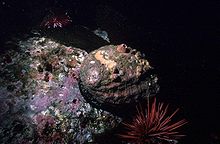
Haliotis cracherodii, the black abalone, is a species of large edible sea snail, a marine gastropod mollusk in the family Haliotidae, the abalone.

Haliotis australis, common name the queen pāua,yellowfoot pāua, or austral abalone, is a species of edible sea snail, a marine gastropod mollusk in the family Haliotidae, the abalone.
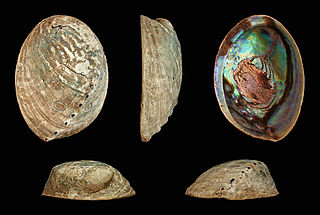
Haliotis iris, common name pāua, blackfoot pāua or rainbow abalone, is a species of edible sea snail, a marine gastropod mollusk in the family Haliotidae, the abalone.

Haliotis laevigata, common name the smooth Australian abalone or greenlip abalone or whitened ear shell, is a species of sea snail, a marine gastropod mollusk in the family Haliotidae, the abalone.
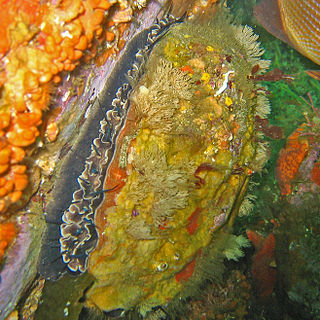
Haliotis rufescens is a species of very large edible sea snail in the family Haliotidae, the abalone, ormers (British) or pāua. It is distributed from British Columbia, Canada, to Baja California, Mexico. It is most common in the southern half of its range.

The blood-spotted abalone is a species of edible sea snail, a marine gastropod mollusk in the family Haliotidae, the abalones. This species is common on rocky shores on the coast of South Africa.

The blacklip abalone, Haliotis rubra, is an Australian species of large, edible sea snail, a marine gastropod mollusk in the family Haliotidae, the abalone.

Haliotis gigantea, common name the giant abalone, is a species of sea snail, a marine gastropod mollusk in the family Haliotidae, the abalones. It is also known as Siebold's abalone, after Philipp Franz von Siebold.
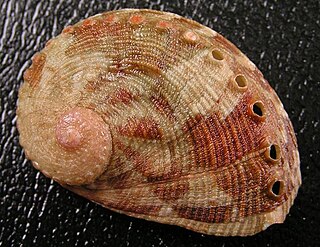
Haliotis coccoradiata, common name the reddish-rayed abalone, is a species of sea snail, a marine gastropod mollusk in the family Haliotidae, the abalones.

Haliotis cyclobates, common name the whirling abalone or the circular ear shell, is a species of sea snail, a marine gastropod mollusk in the family Haliotidae, the abalone.

Haliotis fulgens, commonly called the green abalone, is a species of large sea snail, a marine gastropod mollusc in the family Haliotidae, the abalones. The shell of this species is usually brown, and is marked with many low, flat-topped ribs which run parallel to the five to seven open respiratory pores that are elevated above the shell's surface. The inside of the shell is an iridescent blue and green.

Haliotis glabra, commonly called glistening abalone, is a species of sea snail, a marine gastropod mollusk in the family Haliotidae, the abalones.

Haliotis midae, known commonly as the South African abalone or the perlemoen, is a species of large sea snail, a marine gastropod mollusk in the family Haliotidae, the abalones.

Haliotis ovina, common name the sheep's ear abalone, is a species of sea snail, a marine gastropod mollusk in the family Haliotidae, the abalones.
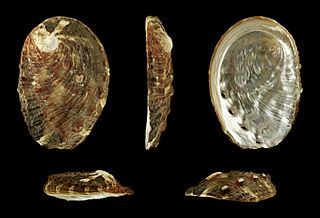
Haliotis planata, common name the planate abalone, is a species of sea snail, a marine gastropod mollusk in the family Haliotidae, the abalone.

Haliotis pulcherrima is a species of sea snail, a marine gastropod mollusk in the family Haliotidae, the abalone.

Haliotis roei, common name Roe's abalone, is a species of sea snail, a marine gastropod mollusk in the family Haliotidae, the abalone.

Haliotis scalaris, common name the staircase abalone or the ridged ear abalone, is a species of sea snail, a marine gastropod mollusk in the family Haliotidae, the abalone.

Haliotis clathrata, common name the lovely abalone, is a species of sea snail, a marine gastropod mollusc in the family Haliotidae, the abalones.

Haliotis, common name abalone, is the only genus in the family Haliotidae.
